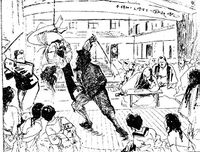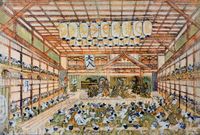History of SM Shows
The history below is an inclusive categorization of bondage, torment and/or erotic sadomasochism in live theater in Japan.
 “Flesh Market” at the Kannon Theater in Asakusa. From Seiu Ito’s “Non-Fiction - Sexual Fluids (11)”. Kitan Club Dec 1954 issue. |
Edo Period Theater
1678: "Sansho Dayu Anju-Hime," in Moronobu Hishikawa's "The Story of Actors Past and Present."[※ 1] Itahashiya-Hime is abused with her hands tied behind her back. By this time, torment scenes were already being hinted at in kabuki theater.
1700s: Punishment scenes in kabuki and ningyō jōruri (puppet theater accompanied by shamisen) are thought to rattle a person's mind.[citation needed]
1740: "Steps of Chujohime's Torment" (step three from "The Mountain Goddess Sutematsu" by Namiki Sousuke).
1772: "Akegarasu Yume no Awayuki"[1]
Meiji Theater
1872: "Kaidan Shikishima Monogatari" by Mokuami Kawatake is first performed by Tanosuke Sawamura III at Moritaza in March.
Modern Theater
1921: "Burning Her Alive" by Senzaburo Suzuki is performed at the Imperial Playhouse in November.[※ 2] The main character and setting is modeled after Seiu Ito and his studio at the time.
2014: Oct. "Nagauta Bo Shibari" at Kameari Lirio Hall
Pink Live Shows
SM Shows
Notes
- ↑ A work of Shinnai jōruri recitation
References (※)
- ↑ Edo Period Literature (Tosho Kankokai, 1916)
- ↑ Ko Minomura. "A Great Star Has Fallen" (SM Collector, Nov 1980)
